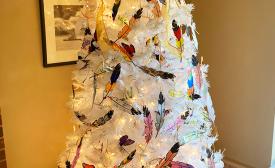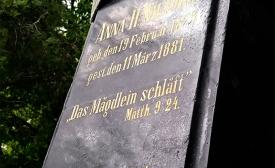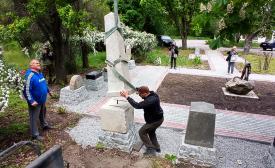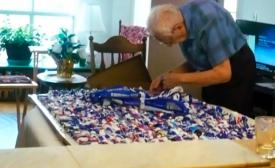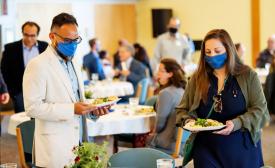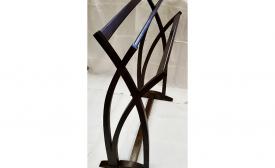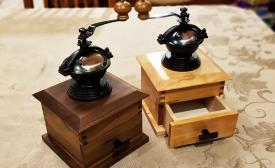Volume 25 Issue 14D
Smile!
Are you finding it hard to smile these days? So much heaviness weighs down on the world. In the face of all that is wrong around us, we strive to be responsible citizens, kind people and faithful followers of Jesus. But sometimes it’s hard to find much good news.
What makes you happy?
“So . . . what’s next??”
The dreaded question for every graduate.
It’s been a few years (plus a few more!) since I graduated from high school and university, but I still remember this sense that, come graduation, I needed to have a roadmap of my future aspirations ready to explain in one easy sentence. No problem, right? Should be easy enough! (Insert “zany face” emoji here.)
Lamenting the loss of young Indigenous lives
Following the discovery of the remains of 215 children on the grounds of the former Kamloops (B.C.) Indian Residential School by the Tk’emlúps te Secwépemc First Nation, Mennonite Central Committee (MCC) laments the loss of these young lives.
Members from MC Canada delegation share what they learned
Members of a Mennonite Church Canada delegation attended the virtual conference hosted by NAIITS—An Indigenous Learning Community from June 3 to 6.
T-shirts encourage Mennos to get vaccinated
When Ryan Polinsky designed T-shirts emblazoned with the words “Menno & Vaccinated” at the beginning of June, he intended to sell only a few to his family. He has since sold around 50 shirts, plus other merchandise like mugs, buttons and hats. Dr. Joss Reimer, medical lead for the Manitoba Vaccine Implementation Task Force, even highlighted the shirts in a provincial press conference.
‘I didn’t know that was going on’
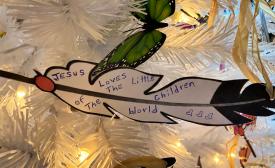
Some residents of Bethany Manor chose to write on their feathers. This one reads: ‘Jesus loves the little children of the world.’ (Photo by Angela Schmiemann)
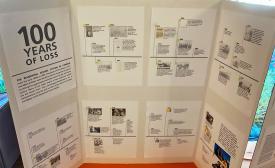
Angela Schmiemann created this timeline depicting the history of Indian Residential Schools as part of an interactive display at Bethany Manor, a seniors residence in Saskatoon. (Photo by Angela Schmiemann)
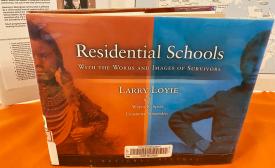
Books about residential schools borrowed from the local public library added to the display and enhanced the seniors’ learning experience. (Photo by Angela Schmiemann)
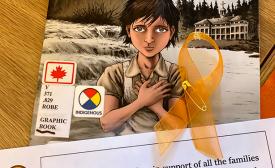
Residents were invited to wear an orange ribbon in support of Indigenous families and communities who lost children to the residential school system. (Photo by Angela Schmiemann)
What do a handful of library books, a white Christmas tree and coloured paper feathers have in common? They were all part of an interactive educational response to the injustice of Indian Residential Schools.
Memorial created from unearthed Mennonite gravestones in Ukraine
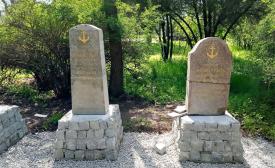
Two Mennonite gravestones were pieced back together and restored for the memorial. (Photo by Max Shtatsky)
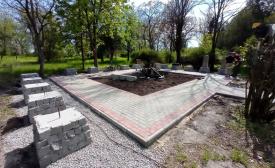
The Mennonite memorial will feature 15 of the 120-plus headstones that were recovered from the foundation of an old barn. (Photo by Max Shtatsky)
Two years ago, a Ukrainian researcher began excavating the foundation of a dilapidated brick barn in Zaporozhye, Ukraine. Using shovels and picks, he began to unearth the rubble. Then he started to notice the German inscriptions on the broken stones. These turned out to be Mennonite gravestones.
After the pandemic, churches look to move forward
Congregations will resume some sort of gathering after the major concerns about COVID-19 are minimized and regulations are relaxed. Talk of getting “back to normal” is common. What will the new normal look like?
Book study group explores healthy masculinity

Clockwise from bottom, Don Neufeld, the editor of Peaceful at Heart; David Blow, Mennonite Central Committee program associate, top left; and Rod Friesen, an MCC restorative justice program coordinator, plan their agenda for week four of the online book club they facilitate dealing with healthy masculinity. (Screenshot by Rod Friesen)
For years Don Neufeld dreamed about providing a space where men could explore healthy masculinity from an Anabaptist/Mennonite perspective. During the month of June he co-facilitated an online book study for a diverse group of men, using a resource he co-edited with Steve Thomas, called Peaceful at Heart: Anabaptist Reflections on Healthy Masculinity.
Men weave plastic milk bags into sleeping mats
It takes 250 plastic milk bags to make a one-metre-x-two-metre washable, waterproof sleeping mat. And it takes hours of volunteer work to flatten, cut, loop and weave strips of the bags together.
A group of men from Wilmot Mennonite Church has been doing this work for years, sending the finished mats to Christian Aid Ministries in Moorefield, Ont., to be distributed mostly overseas.
Small size makes Mennonite school adaptable in COVID-19 reality

A community highlight of the year came with a Taskmaster event. The students were told to dress in school colours, and they entered the festive auditorium to discover that classes had been cancelled and the whole day was filled with unique challenges. (Photo courtesy of UMEI)

UMEI's future music teacher, Erin Armstrong is the founder and director of Music Moves Kids and Abridged Opera, conductor of the Windsor Community Choir, music director of Leamington United Church, and a regular performer/collaborator with the Windsor Symphony Orchestra. (Photo courtesy of Erin Armstrong)
Last year was supposed to be full of celebrations for the 75th anniversary of UMEI Christian High School (formerly United Mennonite Educational Institute). Instead, the pandemic shut things down right after the first big event, a coffee house of music and drama by staff and alumni of the small Mennonite school.
MDS a partner in Texas rebuilding effort
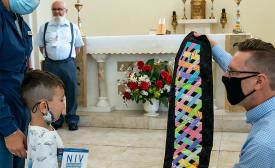
Ron Guenther, MDS’s director of operations, right, presents a quilt to Misty Minshew and her son on May 20 during a dedication service for the last 13 homes in the Tierra de Esperanza, or “Land of Hope,” community in Woodsboro, Texas, four years after Hurricane Harvey wreaked havoc on the area. (MDS photo by Paul Hunt)
Mennonite Disaster Service (MDS) and Disaster Aid Ohio, in partnership with the Coastal Bend Disaster Recovery Group, dedicated the last 13 homes in the Tierra de Esperanza, or “Land of Hope,” community in Woodsboro, Texas, on May 20, bringing to completion an unprecedented three-year effort.
Rituals for reconnecting as we emerge from the pandemic
Each year in the Christian worship: Theory and practice class at Anabaptist Mennonite Biblical Seminary, students spend a couple of weeks considering rituals.
‘Woodworking is my meditation’
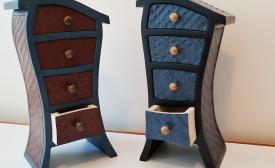
A miniature set of drawers. The wood is carved basswood, painted with milk paint and then burnished to allow the undercoat to show through. (Photo by Gerry Giesbrecht)
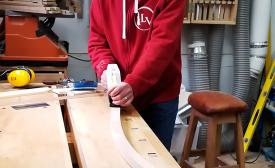
Gerry Giesbrecht of Foothills Mennonite Church in Calgary, in his woodworking sanctuary. (Photo by Pamela Giesbrecht)

Steam-bent plant stand resembling cathedral windows. The bottom and top are poplar and the middle column is birch. (Photo by Gerry Giesbrecht)
When looking for a spiritual activity, a mental-health strategy, or a chance to reflect and see things from a new perspective, woodworking may not immediately come to mind.
Newcomer youth raise money for MCC

Two youth connectors from the Edmonton Mennonite Centre for Newcomers—Emmanuel Mbonimpa of the Congo, left, and Amena Shehab of Palestine, right—delivered 131 hygiene kits to the Mennonite Central Committee Alberta office on behalf of immigrant and refugee youth volunteering at the newcomers centre. Donita Wiebe-Neufeld, MCC Alberta’s development coordinator, centre, was on hand to receive the kits. (Photo by Joanne De Jong)
Edmonton newcomer youth from seven countries raised funds and assembled 131 hygiene kits for Mennonite Central Committee (MCC) recently.







